
The Paramount Theatre is a 1,693-seat theater in Cedar Rapids, Iowa. It was individually listed on the National Register of Historic Places in 1976. In 2015 it was included as a contributing property in the Cedar Rapids Central Business District Commercial Historic District.
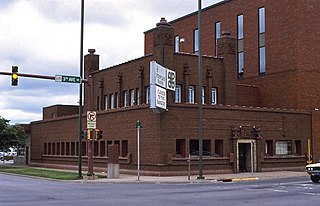
The Peoples Savings Bank in Cedar Rapids, Iowa, was designed by Louis Sullivan. It was the second of a number of small "jewel box" banks in midwest towns designed by Sullivan during 1907 to 1919. It was built in 1911, and it was individually listed on the National Register of Historic Places in 1978. In 2014 it was included as a contributing property in the West Side Third Avenue SW Commercial Historic District.

The Burlington, Cedar Rapids and Northern Railway (BCR&N) was a railroad that operated in the United States from 1876 to 1903. It was formed to take over the operations of the bankrupt Burlington, Cedar Rapids and Minnesota Railway, which was, in turn, the result of merging several predecessor lines, the construction of which began in 1869. The corporate headquarters were in Cedar Rapids, Iowa, and it had operations in Iowa and in Minnesota. It was succeeded by the Chicago, Rock Island and Pacific Railway.

The Linn County Courthouse is located on May's Island in the middle of the Cedar River in Cedar Rapids, Iowa, United States. It, along with the Veterans Memorial Building and two other buildings, is a contributing property to the May's Island Historic District that was listed on the National Register of Historic Places in 1978. The courthouse is the third building the county has used for court functions and county administration.
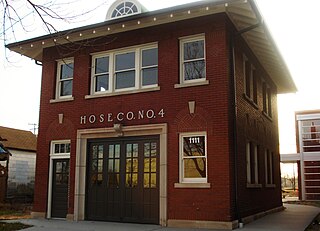
The Bohemian Commercial Historic District, also known as New Bohemia, is located in Cedar Rapids, Iowa, United States. It was listed on the National Register of Historic Places in 2002. At the time of its nomination it consisted of 75 resources, which included 48 contributing buildings, and 27 non-contributing buildings. Bohemian immigrants began settling in Cedar Rapids in the 1850s, and increasingly after the American Civil War in the 1860s and the Austro-Prussian War in 1866. They grew to be the largest ethnic group in the city, and the only one to settle in a distinct part of Cedar Rapids. They settled along the Cedar River between the downtown area and the T.M. Sinclair and Company meat packing plant. The buildings in the district were constructed between the 1880s and the 1930s. They are largely narrow-front commercial buildings and corner blocks. The buildings housed a variety of commercial establishments: a movie theater, two banks, and several filling stations. It also includes a railroad corridor factory building, a fire station, and fraternal halls. The buildings are representative of various commercial architectural styles and vernacular building forms popular at the times they were built. The Lesinger Block (1883) and the C.S.P.S. Hall (1891) are individually listed on the National Register of Historic Places.
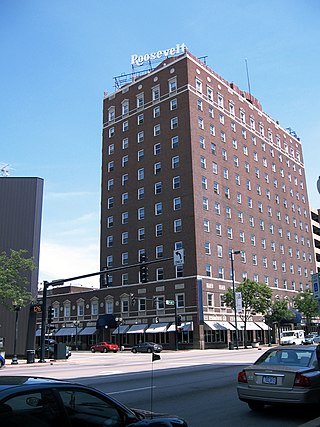
The Hotel Roosevelt is a historic structure located in downtown Cedar Rapids, Iowa, United States. It was individually listed on the National Register of Historic Places in 1991. In 2015 it was included as a contributing property in the Cedar Rapids Central Business District Commercial Historic District. The building is now known as the Roosevelt Lofts.

The Security Building is a historic structure located in downtown Cedar Rapids, Iowa, United States. The building is eight stories tall and rises 117 feet (36 m) above the ground. It was designed by the Cedar Rapids architectural firm of Josselyn & Taylor, and it was completed in 1908. The building was individually listed on the National Register of Historic Places in 1977. In 2015 it was included as a contributing property in the Cedar Rapids Central Business District Commercial Historic District.

The Cedar Rapids Post Office and Public Building, also known as the Witwer Building, is a historic building located in downtown Cedar Rapids, Iowa, United States. It was individually listed on the National Register of Historic Places in 1982. In 2015 it was included as a contributing property in the Cedar Rapids Central Business District Commercial Historic District.

The Belle Plaine Main Street Historic District is a nationally recognized historic district located in Belle Plaine, Iowa, United States. It was listed on the National Register of Historic Places in 2013. At the time of its nomination it contained 63 resources, which included 46 contributing buildings, one contributing structure, and 16 non-contributing buildings. The historic district covers most of the city's central business district. Belle Plaine was laid out in 1862 as a railroad town. The Chicago & North Western Railroad was extended from Cedar Rapids the following year. The commercial district is adjacent to the tracks. A major fire destroyed much of the business district in 1894. Thirty-five buildings in the district were built in the months after the fire.

The Waterloo West Commercial Historic District is a nationally recognized historic district located in Waterloo, Iowa, United States. It was listed on the National Register of Historic Places in 2014. At the time of its nomination the district consisted of 25 resources, including 22 contributing buildings, and three non-contributing buildings. The buildings are from one to three stories in height, and for the most part are clad in brick. The earliest building dates to 1882 and the latest, as of 2014, to 2000. For the must part they utilize the Victorian, Romanesque Revival, and Italianate commercial styles. Ornamentation is minimal. The buildings are all commercial structures with the exception of the former Burlington, Cedar Rapids and Northern Railway Depot, designed by the Cedar Rapids architectural firm of Josselyn & Taylor. Several of the buildings housed automobile-related businesses that clustered along West Fifth Street beginning in the 1920s and 1930s.
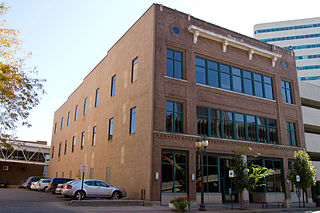
The Lattner Auditorium Building is a historic building located in Cedar Rapids, Iowa, United States. Paul Lattner, who owned Cedar Rapids Auto & Supply Company, had this building constructed for his business in 1910. The first floor was an automobile showroom, the second floor was used for auto storage, and the third floor housed a neighborhood dance hall. Because this is an early example of an automobile related business, the dance hall/auditorium may have been included to ensure the building's economic viability given the nature of the automobile business at that time. Various auto-related businesses continued to occupy the building until 1935.

The Marion Carnegie Public Library is a historic building located in Marion, Iowa, United States. The Marion Federation of Women's Clubs was established in 1901 with the purpose of organizing a public library. Adeliza Daniels was the primary force behind the organization, and she contacted Andrew Carnegie to donate funds for the building. After he agreed to a grant of $11,500, the Cedar Rapids architectural firm of Dieman and Fiske designed the brick Neoclassical building. Cedar Rapids contractor A.H. Conner was responsible for construction. It is a single-story structure built over a raised basement and a proment pedimented main entrance. The new library was dedicated on March 16, 1905, and served the community in that form until 1957. In that year the auditorium in the basement was remodeled into a children's reading room. A three-story addition, which doubled the size of the building, was completed in 1961. The building was individually listed on the National Register of Historic Places in 1994. The Marion Public Library has subsequently moved to a new facility, and the Carnegie building is now part of the First United Methodist Church complex. In 2009 it was included as a contributing property in the Marion Commercial Historic District.

Grant Vocational High School, also known as the Board of Education and the Cedar Rapids School District Central Office, is a historic building located in Cedar Rapids, Iowa, United States. Completed in 1915, this is a rare example of a vocational high school in Iowa as only a handful were ever built. While it offered various student activities in athletics and the arts, its curriculum was based on the manual arts instead of humanities or college preparatory courses. A Progressive Era idea, vocational education began in Cedar Rapids in 1904. Within a year there was a call for a dedicated vocational high school. There was much debate as the local school district's regular high school was beyond capacity and there was a need for new elementary schools. Efforts to build the school began with the passage of a bond referendum in 1911. Cedar Rapids architect William J. Brown designed the three-story, brick Prairie School structure and it was built by the F.P. Gould Company of Omaha.

Sokol Gymnasium is a historic building located in Cedar Rapids, Iowa, United States. Sokol is a Czech social and gymnastics organization. It had this three-story, brick, Neoclassical structure built in 1908. It was designed by local architect Charles A. Dieman. The organization used the facility as a social hall and gymnasium until it was inundated by 4 feet (1.2 m) of water in a 2008 flood. It was cleared out and Sokol moved to another building in southwest Cedar Rapids. This building was individually listed on the National Register of Historic Places in 2013. In 2015 it was included as a contributing property in the Cedar Rapids Central Business District Commercial Historic District.

The Harper and McIntire Company Warehouse, also known as Smulekoff's Warehouse, is a historic building located in Cedar Rapids, Iowa, United States. Harper and Mcintire was a wholesale hardware business that was established in Ottumwa, Iowa in 1856. A branch warehouse in Cedar Rapids was begun in 1921. The four-story, brick, Commercial structure was designed by the Minneapolis architectural firm of Croft and Boerner. Cedar Rapids contractor Theodore Stark & Company and Ferro Concrete Construction Company of Cincinnati were responsible for construction. The building was completed in 1922 in an industrial area where spur lines connected it to the Fourth Street Railroad Corridor. It was originally designed as a seven-story building, but by the time it was put out for bid it was reduced to four-stories with a two-story tower that enclosed a water tank. Two additions were added to be building that facilitated the change to shipping by truck. The east side addition was completed in the 1940s, and the west side addition (1962) was built where the railroad spur track had been located. Smulekoffs Furniture Company took over the building in 1981 and remained until 2014 when they went out of business. The building was listed on the National Register of Historic Places in 2015.

The Cedar Rapids Central Business District Commercial Historic District is a nationally recognized historic district located in Cedar Rapids, Iowa, United States. It was listed on the National Register of Historic Places in 2015. At the time of its nomination it consisted of 60 resources, which included 46 contributing buildings, one contributing structure, 12 non-contributing buildings, and one non-contributing structure. Cedar Rapids was platted on the east bank of the Cedar River as Rapids City in 1841, and it was incorporated under the same name in 1849. Kingston was established on the west bank of the river in 1852. The two smaller communities consolidated in 1870 as Cedar Rapids. The streets were laid out parallel and perpendicular to the river, which flowed from the northwest to the southeast. The Chicago, Iowa and Nebraska Railroad was the first to arrive in the community in 1859 and the tracks were laid on Fourth Street on the eastern edge of the central business district. The first bridge across the river was built at Third Avenue in 1871.
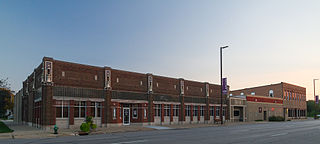
The West Side Third Avenue SW Commercial Historic District is a nationally recognized historic district located in Cedar Rapids, Iowa, United States. It was listed on the National Register of Historic Places in 2014. At the time of its nomination it consisted of 10 resources, which included seven contributing buildings and three non-contributing buildings. Cedar Rapids was platted on the east bank of the Cedar River as Rapids City in 1841, and it was incorporated in 1849. Kingston was established on the west bank of the river in 1852, and it was annexed by Cedar Rapids in 1870. The streets were laid out parallel and perpendicular to the river, which flowed from the northwest to the southeast. The Chicago, Iowa & Nebraska Railway, later the Chicago & North Western Railway, was the prominent railroad on the west side of town. The first bridge across the river at Third Avenue was built in 1871. The current bridge was completed in 1912. Prior to a bridge, Rapid City and Kingston were connected by a ferry operated by David W. King, the founder of Kingston.

The Cedar Rapids Milk Condensing Company, also known as Knutson Building, and the Chelsea, is a historic building located in Cedar Rapids, Iowa, United States. It was built in 1887, and it is one of the few commercial structures that remains along the west side of the Cedar River from that era. Besides the Cedar Rapids Milk Condensing Company, the building was also used by the Knutsons for their junk business. It was used for storage and it was also used as a haunted house before it could no longer be occupied. The building has been transformed into 18 market-rate apartments called the Chelsea. It was listed on the National Register of Historic Places in 2017.

The Shores-Mueller Company is a historic building located in Cedar Rapids, Iowa, United States. The original section of the building was completed in 1911. Its construction utilized the Turner Cap system, which is a concrete flat-slab support system. It features concrete floors that are more than 1 foot (0.30 m) thick and are supported by large concrete columns with concrete caps. The building housed the catalog company Shores-Mueller, which produced, packaged, and sold a variety of household and farm products from here. Two additions were built on to the original structure, the last being in 1969. The building is three-stories, constructed in brick, and lacking in ornamentation. Tom Erger, Devonna Wood, and Mike Pitzen acquired the building in 2005 and renovated it into the Shores Central Park, which hosts a variety of functions. It was listed on the National Register of Historic Places in 2020.

The Iowa City Downtown Historic District is a nationally recognized historic district located in Iowa City, Iowa, United States. It was listed on the National Register of Historic Places in 2021. At the time of its nomination it consisted of 102 resources, which included 73 contributing buildings, one contributing site, one contributing object, 21 non-contributing buildings, and seven non-contributing objects. Eight buildings that were previously listed on the National Register are also included in the district. Iowa City's central business district developed adjacent to the Iowa Old Capitol Building and the main campus of the University of Iowa. This juxtaposition gives the area its energy with the overlap of university staff and students and the local community. The district was significantly altered in the 1970s by the city's urban renewal effort that brought about the Ped Mall, which transformed two blocks of College Street from Clinton Street to Linn Street and Dubuque Street from Burlington Street to Washington Street. It is the contributing site and the large planters/retaining walls that are original to the project are counted together as the contributing object. There are also several freestanding, limestone planters, five contemporary sculptures, and a playground area are the non-contributing objects.























